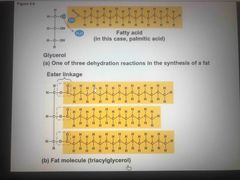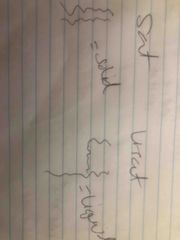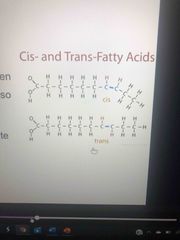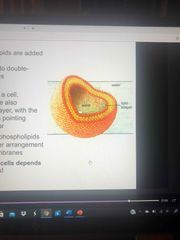![]()
![]()
![]()
Use LEFT and RIGHT arrow keys to navigate between flashcards;
Use UP and DOWN arrow keys to flip the card;
H to show hint;
A reads text to speech;
19 Cards in this Set
- Front
- Back
|
4 large biological molecules |
Carbohydrates Lipids Proteins Nucleic acids |
|
|
Macromolecules |
Large complex molecules |
|
|
Lipids |
One class of lrg molecules that do not include true polymers Hydrophobic bc. They. Consist of hydrocarbons which firm nonpolar covalent bonds |
|
|
Types of lipids |
Fats Phospholipids Steroids |
|
|
Fats |
Made of 2 types of smaller molecules: glycerol and fatty acids |
|
|
Glycerol |
3 carbon alcohol and in the hydroxyl group attached to each carbon |
|
|
Fatty acid |
Consist of carboxyl group attached to a long carbon skeleton, the rest is non polar C-H Fatty acids can be all the same ot 2 or 3 different kinds Can vary in length and locations of double bonds |
|
|
Ester linkage |

Hydroxyl group that reacts with water to join a carboxyl group |
|
|
Triacylglycerol |
In fat 3 fatty acids are joined to glycerol by an eater linkage |
|
|
Saturated fat |
Maximum number of hydrogen atoms and no double bonds Solid at room temp (butter) |
|
|
Unsaturated fatty acids |
Have one or more double bonds In the cis group Liquid at room temperature Oils, plant fats, fish fats |
|
|
Saturated versus unsaturated at room temp |

Sat: solid at room temp due to more dense Unsat: liquid at room temp due to less dense |
|
|
Hydrogenation |

Process of converting unsaturated fats to saturated fats by adding hydrogen Hydrogenating vegetables oils create unsaturated fats with trans double bonds Can change cis to trans |
|
|
Trans fats |
Contribute more than sat fat to cardiovascular disease |
|
|
Fats in energy storage |
Humans and other mammals store their LT food reserves in adipose cells Adipose tissue also cushions vital organs and insulated the body 1 gram of fat stores 2x as much as a polysaccharide |
|
|
Phospholipids |
2 fatty acids and a phosphate group are attached to glycerol 2 fatty acid tails are hydrophobic but the phosphate group and its attachments form a hydrophilic head This is the basis for cell membrane so it is important for the existence of cells |
|
|
Phospholipids bilayers |

When phospholipids are added to water, they Self-assemble The hydrophobic tails connect and the hydrophilic heads bond for a layer |
|
|
Steroids |
Lipids characterized by a carbon skeleton consisting of 4 rings |
|
|
Cholesterol |
A type of steroid A component in animal cell membranes A precursor molecule for other steroids A high level fee floating in the blood can contribute to cardiovascular disease |

